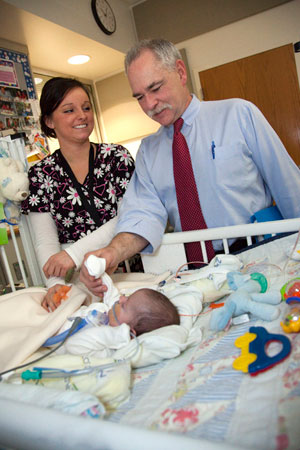Q&A with Our Top Safety Officer, Stephen Muething, MD
Q: What is the most common misconception about the role of the vice president for safety?
A: That he or she owns accountability for safety within the hospital. Safety is the responsibility of everyone, from the chair of the board on down. It doesn’t just belong to the safety officer or the safety team.
Q: How then do you see your role?
A: Don’t get me wrong, the role of the top safety officer is critical. I believe it’s my job to establish the vision for safety and help shape strategic goals. The safety officer works to identify problems and helps find solutions where they exist. Where they don’t, we have to look outside of healthcare for expertise that might provide the answer. I do a lot of work interpreting high reliability theory into practical application since we see safety as an outcome of being an HRO (high reliability organization). It’s also the safety officer’s job to focus the organization’s attention in the right direction and keep the work on track. We need to relentlessly drive toward improvement, and that is my responsibility. But I don’t take on fixing each problem myself, because if I did, the change would be too slow. Everyone in the organization has to have a real sense of urgency about the work and be contributing for us to be successful.
Q: What does a typical day consist of for you?
A: I don’t think there is a typical day. I try to find the right balance between being here and traveling to learn from other hospitals and industries and to share our work. When I am on campus, I attend our DOB (daily operational brief) whenever possible − it helps not just me, but leaders throughout the organization get a pulse of the hospital and potential “hot spots” to pay attention to. I think it’s important that the safety officer be accessible. I coach a number of teams through their improvement work. I participate and help lead root cause analyses. I confer with leaders and frontline teams regarding concerns. I spend time listening to and talking with the frontline staff. They are the ones who really keep our patients and each other safe.
Q: What is the role of patients and families with regard to safety?
A: Patients and families play a number of important roles within our hospital, and it was a big step for us when we started putting them on our teams. But for me, the most important thing is that they remind us of how devastating harm is to everyone involved, and that it is simply not acceptable. They don’t allow us to get comfortable with what we have achieved. Families also play a real-time role in helping us avoid harm. Parents help by telling us when they have concerns. No one knows their children better than they do. When they are worried, we need to stop and listen. Often their gut feelings are strong signals that something is not right.
Q: Any closing thoughts?
A: Thanks for all you do to keep ’em all – employees and patients – safe.




